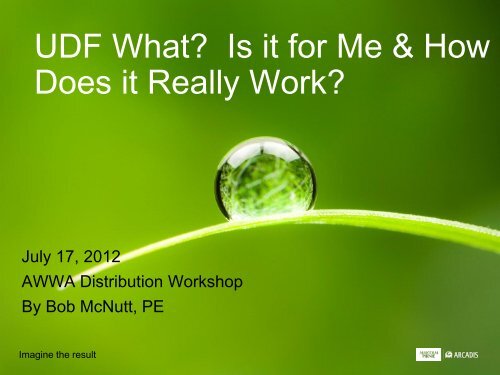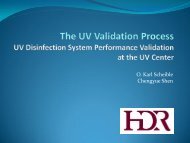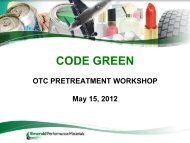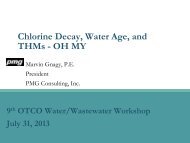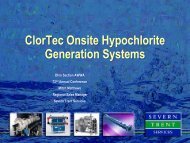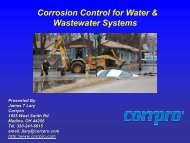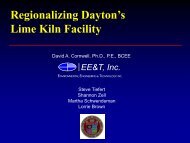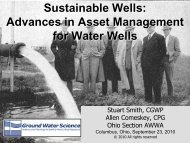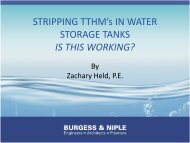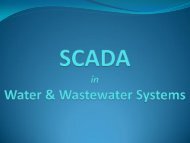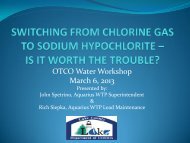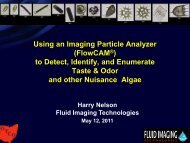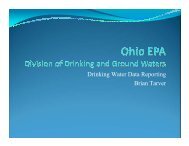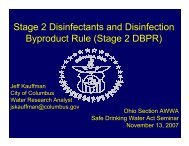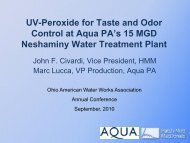Unidirectional Flushing - Ohiowater.org
Unidirectional Flushing - Ohiowater.org
Unidirectional Flushing - Ohiowater.org
- No tags were found...
Create successful ePaper yourself
Turn your PDF publications into a flip-book with our unique Google optimized e-Paper software.
UDF What Is it for Me & How<br />
Does it Really Work<br />
July 17, 2012<br />
AWWA Distribution Workshop<br />
By Bob McNutt, PE<br />
Imagine the result
Main Points<br />
• Your WDS needs flushed<br />
• UDF is another tool, not a silver bullet<br />
• Must define your goals, desired outcome
Outline<br />
Define WDS flushing approaches<br />
Advantages/Disadvantages for each flushing approach<br />
How UDF works - Pilot studies and results<br />
Lessons learned
Purpose of <strong>Flushing</strong><br />
1. What’s in your pipes
Define WDS<br />
flushing<br />
approaches
WDS <strong>Flushing</strong> Approaches<br />
Conventional flushing<br />
Spot flushing – water quality concerns<br />
<strong>Unidirectional</strong> <strong>Flushing</strong> (UDF) approach
Conventional <strong>Flushing</strong><br />
Open hydrants "randomly"<br />
Flush large quantities of water<br />
Pulls water through many mains<br />
No valve turning<br />
Random or no water quality checking
<strong>Unidirectional</strong> <strong>Flushing</strong> (UDF)<br />
Specific, orderly flushes, follow sequence, minimum # of<br />
hydrants used<br />
Higher flushing velocities to scour the water main<br />
Pulls water thru one segment of main - moving from clean<br />
thru the dirty pipes<br />
Close valves to strategically direct the flow of water from<br />
clean into dirty pipes deeper clean removing sediment,<br />
tuberculation & biofilm<br />
Significant water quality checking
Advantages and<br />
Disadvantages<br />
for each flushing<br />
approach
Conventional – Advantages<br />
• Familiarity of staff with program<br />
• Simplicity of approach<br />
• Provides adequate water quality short term<br />
• Improves short term aesthetics of the water (taste, odor,<br />
visual)
UDF - Advantages<br />
• Typically saves 40% of water and 40% of labor vs.<br />
conventional<br />
• More control on direction, velocities, and thus results<br />
• Hard flushes every 2 to 3 years vs 2X per year<br />
• Scouring velocities remove sediment and deposits = clean<br />
• Dislodges biofilm & curbs bacteria regrowth in WDS<br />
• Restores hydraulic capacity<br />
• Provides adequate water quality, longer term
UDF - Advantages<br />
• Improves aesthetics of the water (taste, odor, visual)<br />
• Improves water quality & reduces water age<br />
• Reduces disinfectant demand and DBP concentrations<br />
• Typically uses fewer fire hydrants<br />
• Benefit of valve exercising during UDF<br />
• Improves knowledge of WDS network and operations<br />
• Minimum disturbance to customers and reduced dirty<br />
water complaints following flushing
Conventional -<br />
Disadvantages<br />
• Does not scour WDS pipes, remove biofilm or sediments<br />
adequately (inefficient cleaning)<br />
• Does not exercise valves<br />
• Uses more billable water than UDF<br />
• Performed 2X annually (typically)<br />
• Dirty water can be pulled into previously cleaned mains
UDF - Disadvantages<br />
• More costly first year to develop the program<br />
• Train staff<br />
• Fix inoperable valves<br />
• Implement program<br />
• Operators must learn new program
How UDF works<br />
– Pilot studies<br />
and results
Case Studies –<br />
Representative Clients<br />
• Tallahassee, Florida (How it works)<br />
• North Canton, Ohio<br />
• Norwalk, Ohio<br />
• Hudson, Ohio<br />
• Streetsboro, Ohio
Tallahassee Model Background<br />
1. Modeled in InfoWater<br />
2. Created in 2009/2010<br />
3. All pipes model<br />
1. 1,218 miles of water mains<br />
2. 41,000 pipes in the model<br />
4. 28 ground water wells<br />
1. Chlorine is added to well<br />
discharge and pumping<br />
directly into distribution<br />
system<br />
5. 8 elevated storage tanks<br />
6. Two pressure zones
Why Flush in Tallahassee<br />
- Iron Bacteria and Customer Complaints
Innovyze – InfoWater UDF Module
Flush Sequence Manager<br />
- Sequence Setup
Flush Sequence Manager<br />
- Sequence Setup
Flush Sequence Manager<br />
- Results
Flush Sequence Manager<br />
- Results
Field Journals
Results<br />
• Program still requires lots of WDS knowledge<br />
• Program does not tell you when pressures may be<br />
excessively high<br />
• WDS finds valves and/or other restrictions that were<br />
previously unknown<br />
• May result in MORE red water complaints
Results – Representative<br />
Clients<br />
• Tallahassee, Florida – high pressures<br />
• North Canton, Ohio – replace bad water main instead<br />
• Norwalk, Ohio – hidden hydraulic restrictions<br />
• Hudson, Ohio – complete in-house, cost effective<br />
• Streetsboro, Ohio – water quality model instead
Lessons Learned
Lessons Learned<br />
• Evaluate the options available to resolve problem<br />
• Not all situations need UDF, case by case review<br />
• Program does not tell you when pressures may be<br />
excessively high, care in choosing valves to close<br />
• Operators find valves and/or other restrictions that were<br />
previously unknown<br />
• May result in MORE red water complaints
Lessons Learned<br />
• Consider ROI as an evaluation method<br />
• Cost savings not always enough to justify<br />
• Save $4,350 annually vs. $30,000 UDF, 7 yr ROI<br />
• In house versus consultant<br />
• ROI may be too long, program too costly (purpose of<br />
program not justified by cost of program)<br />
• Non-cost issues, valve exercising, holistic knowledge of<br />
WDS, etc, may sway decision to go with a UDF
Take Home Points<br />
• Your WDS needs flushed<br />
• UDF is another tool, not a silver<br />
bullet<br />
• Must define your goals, desired<br />
outcome (case by case evaluation<br />
of effectiveness for problem<br />
resolution)
Imagine the result<br />
CONTACT DATA:<br />
Bob McNutt, PE<br />
Ph: 330-515-5674<br />
Cell: 330-697-0437<br />
Bob.mcnutt@arcadis-us.com


